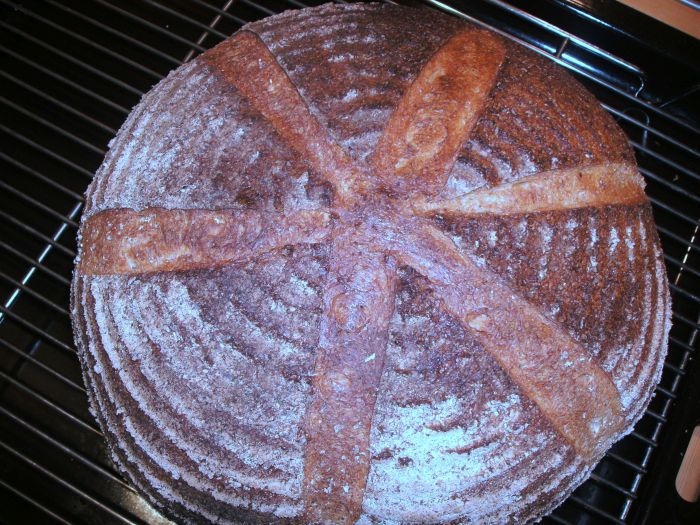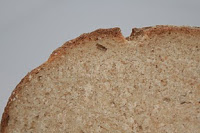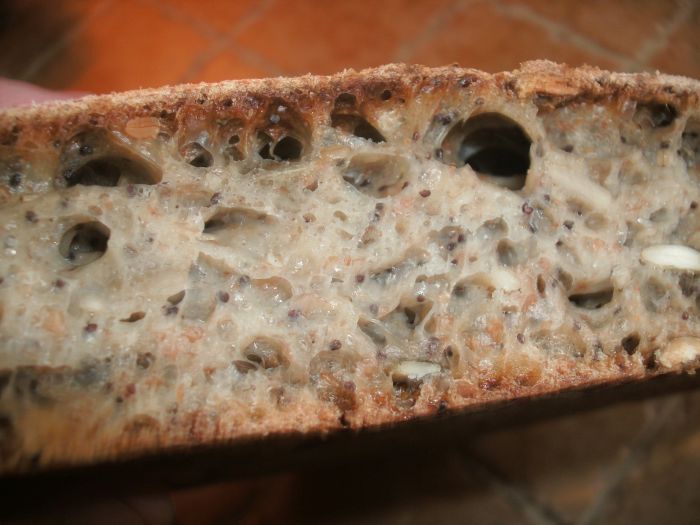In January I posted this article on how to make sourdough bread. I was amazed at how much attention it generated. I was so pleased at how many people contacted me to say they’d started baking sourdough bread as a result. You’ll see by the button on the right that I’m now a member of the growing Real Bread Campaign too. Please check out their site for lots of really useful information.
 Since then I’ve talked, tweeted and met with an exciting bunch of enthusiastic bakers, amateur and professional alike. As a result, the way I make my bread has changed a little from the way I described, so I thought an update might be helpful.
Since then I’ve talked, tweeted and met with an exciting bunch of enthusiastic bakers, amateur and professional alike. As a result, the way I make my bread has changed a little from the way I described, so I thought an update might be helpful.
I’ve made changes in three main areas:
- Hydration – the amount of water in proportion to dry ingredients
- Wholemeal flour proportion
- Baking process
I’ll describe each of these in turn…
How to make sourdough bread – update
Hydration
‘Hydration‘ is ‘baker-speak’ for the amount of water in a dough. It’s measured as a percentage of water by weight realtive to the weight of flour.
The dough in the previous post has a relatively low hydration of 54%. I’ve already written how hydration affects dough in my post about making French Baguettes.
I wanted the crumb of my bread to be more ‘holey’ and for it to have a nicely ‘chewier’ texture. Here’s what the crumb of my loaf in the January post looked like:
 I was aiming for something more like this:
I was aiming for something more like this:
 Or this:
Or this:
 So I’ve changed the hydration of the loaf I make so that it is about 70%. This means that instead of 550g of water in the recipe, I use 670g.
So I’ve changed the hydration of the loaf I make so that it is about 70%. This means that instead of 550g of water in the recipe, I use 670g.
My crumb has improved as a result. The higher hydration does make the dough a little stickier to manage and the loaves are less ‘pert’ than the ones before. Partly, the shape of the finished loaf can be regained by better shaping technique: getting more tension into the dough as you form it for the banetton. I’m getting better at this and have spoken to some good bakers about it. I hope to learn a whole lot more at Mick Hartley’s BethesdaBakin5 event in July this year.
Wholemeal flour
I’ve played a lot with the proportion of wholemeal flour in this recipe. For some things (like bacon sandwiches!) an all-white loaf is perfect. For everyday use, for health, texture and taste reasons, I like to have a partly wholemeal loaf.
In the previous recipe the wholemeal flour is 18% of the total flour. Since then I gradually increased this to 33%. At this level, the loaf felt just too filling for an ‘everyday’ loaf. I’ve settled (for now) on 25% wholemeal which would mean 275g of wholemeal and 835g of strong white flour in the recipe.
As an aside, I’ve made a few all wholemeal loaves since January. They’ve been lovely and nutty, surprisngly light and toast really well too. I think the difference is partly in what you’re expecting from the loaf.
Baking process
Mick Hartley is a baking enthusiast here in North Wales. He bakes fom home and sells to local residents and businesses. He is a force of nature and very generous with advice and has written a Sourdough Primer.
Mick commented generously on the original ‘How to…’ posting. I wanted to try his process for baking to see whether it fitted in to my schedule better than the overnight process. I also wanted to see whether it affected the flavour or handling of the dough too.
Mick’s method, as he commented, is now my preferred method. There’s a bit of work the afternoon/evening before. He kneads, but I fold: partly that’s because it’s easier on my dodgy wrist. The dough goes into the fridge overnight. Because of the low temperature it ferments relatively slowly. This slow fermentation also helps it develop a nice gently ‘sour’ flavour. Bakers call this a ‘retardation’ or ‘the retard’ because of the slowing down of the dough’s fermentation. In the previous method, the overnight pre-ferment of the sponge is designed, in part, to do the same but, obviously, you’re only doing it to a proportion of the dough mix.
In his book Bethesdabasics: Sourdough Made Simple, Mick describes the starter being refreshed the night before and then mixing and making the bread during the course of the day. I’ve tried this and often use it where schedules (or my lack of organisation) do not permit me to fridge ferment. The ‘sour’ taste is consequently not so pronounced.
One interesting observation came from a power cut. A frustratingly common occurrence in the sticks here. I had a dough in the fridge ready to come out in the morning. We lost power until 14:30 that afternoon. Losing the fridge wasn’t the problem, the electric ovens were. The dough still shaped OK but it was over proved. This means that the ferment had used up all the food in the flour and therefore could not generate more gases to lift the loaf. As a result, the loaves were considerably flatter and had a more pronounced sour flavour. Still tasty to eat and not at all heavy, but not what I wanted to produce.
The Baking Fraternity
So there you are. A few lessons and observations that I hope help anyone reading this make decisions about their own bread baking. There’s still loads to learn. What I’m sure about it that my fellow bakers will be generous with their help. I’ve been blown away by the ease with which the baking fraternity will help people learn how to bake. This from top professional bakers to enthusiastic amateurs like me and the occasional baker. Stars all.
Comments
9 responses to “How to make sourdough bread – update”
[…] to do another post about making sourdough bread. Since my first How To Make Sourdough post and the Update, I’ve learnt quite a lot and continue to do […]
Hi Carl,
been reading your sourdough entries – excellent "how to" guides – I am amused that you have also gone down the same Hugh FW "everyday", Lepard's "The handmade loaf" and Bethesdabasics" route as I have!
I am working my way through "bethesdabasics" at the moment having tried the white sourdough and Mick's classic (50-50 wholemeal to white flour) and planning to have a go at the wholemeal one tomorrow. then its the multigrains and the world of "soakers"!
I am interested in what you wrote about fermenting overnight in the fridge. I have never tried that and I like the sound of a more pronounced sour taste. I am going to give the folding technique ago too. Too often I make my bread with a 10 minute knead in the morning before work and let it ferment through the day.
I am looking forward to reading people's stories about the Bethedabakin' event in July. I'm jealous… maybe another year…
Hi Jackie – Patrick is an inspiration in many areas, must have been a great course to be on, thanks for sharing.
Hi Miskmask – Thanks for the feedback and kind comment, I'm sure we can find some prettier pictures for your kitchen though 🙂
Cheers
Carl
This is a top-notch article. I'm tempted to print and frame it, and display it in my kitchen.
ooh also at http://labonnebouffonnerie.blogspot.com/2011/03/sourdough-skill-share.html
from Patrick Whitefield's SLU course which I was also on.
Hi Gail
Thanks for the comment.
You may well be right. It's why I weigh my water carefully rather than use volumes for my water. 50ml (just over 3 tbsp) can make nearly 10% difference to the hydration. That could mean 60% (moderate and easy to work, 'pert loaf')becomes 70% (getting more difficult to work and 'flatter loaf').
However, I've recently had problems with my electronic scales not reading accurately on higher weights. So I've just invested in some new scales from Bakery Bits. Will review them in a future blog.
Thanks for stopping by and for the compliment 🙂
Carl
Realised that my flattish loaf was probably too much water although as you said the flavour and texture of the bread was good.
Great blog!
Joanna
Many thanks for your kind comment. Rhubarb cake on the way, I promise. You are one of the people I was referring to, and bakers are (generally) a very friendly and giving bunch.
Thanks for stopping by…
Carl
What can I say? I love the description of Mick as a force of nature LOL! Your baking is galloping away brilliantly – your risotto looks amazing and I am tapping my nails impatiently waiting for that rhubarb polenta cake recipe… rattle rattle …..